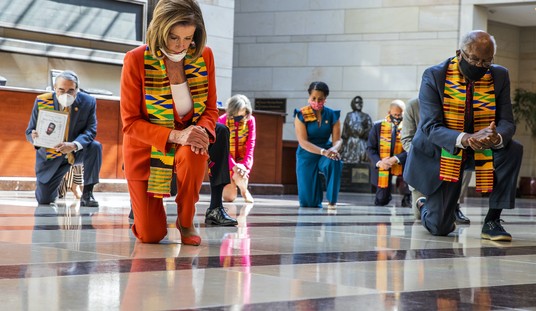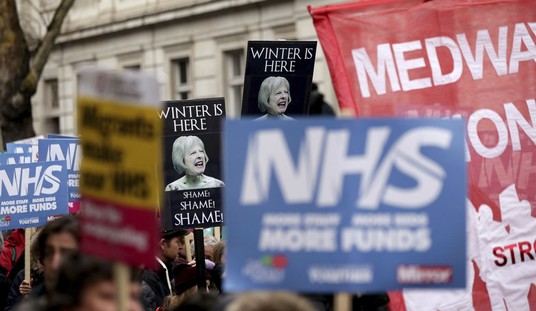Models are hard under the best conditions. Under conditions where you’re modeling an unknown virus and an unprecedented national response, they’re destined to miss badly.
But having to nearly double your death estimate feels like a bad miss even grading on that very steep curve. They were at 72,000 projected deaths by August 4 as of this morning, remember, even thought the confirmed death toll in the U.S. is already north of 60,000.
There’s a long explanation of their updated methodology here. “We, collectively, are now entering a new phase of the COVID-19 pandemic,” they write as states begin easing restrictions. They’ll begin incorporating four variables into their model to try to fine-tune future projections — temperature, population density, testing per capita, and mobility, i.e. people getting out more. The new forecast: 112,000 Americans dead by June 1, with a realistic best-case scenario of 91,000 and a worst-case scenario of 155,000.

Their absolute worst-case scenario for August 4 is 242,000 dead, which would be slightly beyond the worst-case scenario predicted by the White House’s model for the entire epidemic. Weirdly, though, despite the massive upward revision in IHME’s death forecast, they see major progress ahead this month:

Daily deaths in May are a straight sloping downward line, from 2,000 or so currently to just 890 by June 1. The CDC model (or rather, the “unfinished” CDC model) that leaked earlier this afternoon sees a trend in the opposite direction, with deaths increasing during May. The IHME model has been criticized from the start as too optimistic. Arguably it’s still too optimistic, even with its grimmer updated estimate of the cumulative death toll.
“The sharp increases in the two models are tied to relaxed social distancing and increased mobility in the US,” writes CNN about the IHME and CDC revision. The numbers are going up because people are breaking lockdowns! I don’t get that, though. For starters, we don’t know how much or how little social distancing will change just because people are moving around more. It’s safe to say they’ll be less of it, but how much less? The post-lockdown era is still sufficiently new that we have no data yet on whether there’s been a surge in new cases anywhere.
Beyond that, the vagaries of the post-lockdown era don’t explain why IHME missed so badly with its projections during the lockdown era. We’re within two weeks, maybe less, of passing the cumulative death toll they projected following three more *months* of the epidemic. For the next several weeks, every COVID-19 death in the U.S. will derive from a transmission that occurred during the lockdown era. (I’m estimating that the typical infection takes three weeks to progress to fatal.) Why did IHME initially underestimate the death toll so badly? If the answer is that they expected more aggressive social distancing than Americans actually practiced for the past six weeks, I’m not sure what that would have looked like or why they would have considered it realistic. If realizing the most recent projection of 72,000 deaths by August 4 would have required everyone to remain at home and businesses to remain shuttered for the duration of the entire summer then this model was so unrealistic as not to have been useful in the first place.
On the other hand, it’s certainly no worse than the garbage that’s reportedly being produced inside the White House:
White House officials have been relying on other models to make decisions on reopening, including the IHME model and a “cubic model” prepared by Trump adviser and economist Kevin Hassett and the Council of Economic Advisers.
People with knowledge of the “cubic model” say it currently shows deaths dropping precipitously in May — and essentially going to zero by May 15.
Zero deaths 11 days from now, eh, Kev? I’m grateful we have such clear-eyed advisors assessing whether it’s safe to reopen yet.
We did get some good news on deaths today, coincidentally. It comes with the asterisk that deaths almost always come in low based on weekend reporting and then shoot up again on Tuesday, but Nate Silver notes that this is the first day in more than a month that we had fewer than 1,000 fatalities:
US daily numbers via @COVID19Tracking:
Newly reported deaths:
Today: 938
Yesterday: 1,158
One week ago (4/27): 1,163Newly reported cases:
T: 21K
Y: 26K
4/27: 22KNewly reported tests:
T: 232K
Y: 239K
4/27: 190KPositive test rate:
T: 9%
Y: 11%
4/27: 11%— Nate Silver (@NateSilver538) May 4, 2020
Testing is also up above 200,000 per day recently, another positive sign. The better we can find and monitor new cases, the better our ability to prevent transmission.
Here’s the director of IHME discussing the new estimates. Anyone have another model they want to suggest as the industry standard?
WATCH: IMHE model predicts major increase in coronavirus deaths due to "trends in mobility" #MTPDaily
Professor Chris Murray of @IHME_UW: The increase in numbers is because "people are out, getting more active in the last week or 10 days” and relaxed social distancing. pic.twitter.com/COdH5JJV0V
— Meet the Press (@MeetThePress) May 4, 2020








